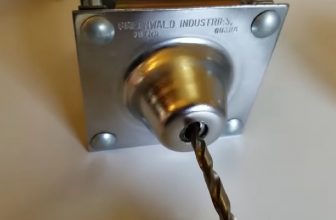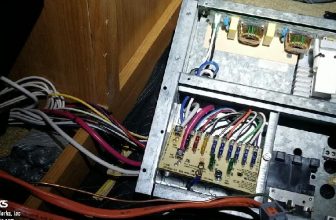How to Date an Antique Ice Box
Have you ever seen an old icebox and wondered how to date it? These relics from a bygone era can be quite interesting, but they can also be challenging to identify. So, we will also discuss some of the different features that you can look for to determine its age.
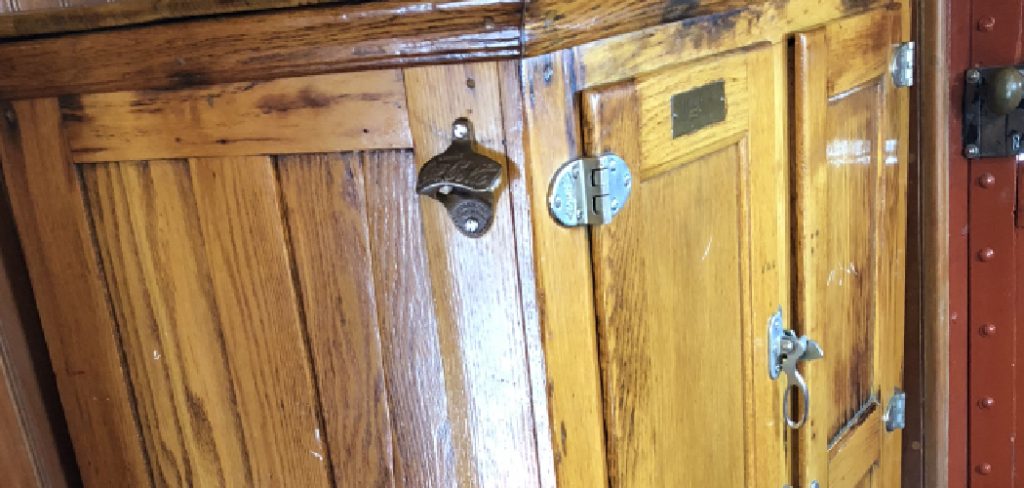
Dating an antique icebox can be a challenge. Several factors to consider, including when the icebox was made and where it was used. In this blog post, we will walk you through the process of how to date an antique ice box. We will also provide some tips on caring for your antique icebox. So if you’re curious about your old icebox, keep reading!
What is an Antique Ice Box?
An antique icebox is a type of refrigeration unit that was used before the invention of modern-day refrigerators. These iceboxes were typically made from wood or metal and were designed to keep food and beverages cool using blocks of ice. They were popular in the late 19th and early 20th centuries, but with the invention of electric refrigerators, they became obsolete.
You can still find antique iceboxes in homes or antique shops, and they make for great conversation pieces. But how do you determine the age of an antique icebox? Let’s find out.
How to Determine the Age of an Antique Ice Box
The Location of Manufacture
One way to determine the age of an antique icebox is by looking at where it was manufactured. Most iceboxes were made in the United States, with popular manufacturers including “The Arctic” and “The Crystal.” Iceboxes made in Europe or other countries may have different designs and features, making them easier to identify.
The Design
Another way to date an antique icebox is by its design. As technology advanced, so did the design of ice boxes. Early iceboxes were simple and boxy, while later models had more intricate designs and features such as shelves and compartments for different types of food. Additionally, the type of material used in the construction can also give clues to its age.
The Hardware
The hardware on an antique icebox can also help determine its age. Handles, hinges, and latches were often made from specific materials that were popular during certain time periods. For example, brass hardware was commonly used in the late 19th century, while nickel-plated hardware became more popular in the early 20th century.
The Label or Stamp
Many antique iceboxes have a label or stamp with information about the manufacturer and sometimes even the date of creation. If you’re lucky enough to find an icebox with this information intact, it can be a significant clue in dating the piece.
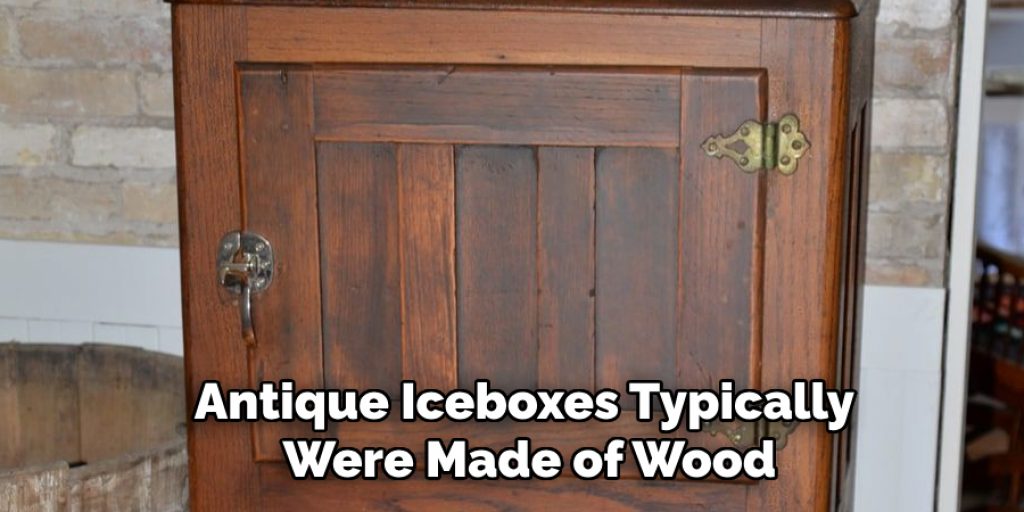
Research
If you’re still unsure about the age of your antique icebox, do some research. Online resources and books on antiques can provide valuable information on different manufacturers and their production timelines. You can also consult with antique experts or join online forums to get help from fellow antique enthusiasts.
8 Effective Ways How to Date an Antique Ice Box:
1. Decals and Labels:
Inspect the icebox for any decals or labels, providing a readily available, complete date. If there is no clear company logo and name and an exact year is needed, you will most likely need to carefully look at all of the typeset words on the front of the icebox since they provide the most information. The words on the back of the appliance are often more decorative than informative.
2. Paperwork:
Some iceboxes will have paper labels or tags with the manufacturer’s name and date on them. If this is not present, then sometimes there were “how to use” instructions included inside of the door hinges. Also, paperwork may have been included with the original purchase of this appliance. It could include a receipt or bill of sale showing the date and cost.
3. Drawer Slides:
The drawer slides can indicate a certain period depending on the style and year of the manufacturer. Use the “Drawer Slides Style” chart to narrow down your possible years if you want an exact answer. This information is usually available on the manufacturer’s website or from an antique dealer. It’s best to compare the size, length, and style of your drawer slides with other models from around that time period.
4. Fasteners:
Many iceboxes used fasteners such as nails and screws to assemble various parts. The types of fasteners used can indicate certain decades. For example, during the 1920s and 1930s, it was common to use wire twist-like nails because screw manufacturing technology wasn’t that great. These nails were used for the most expensive models to help hold them together. Anything with the lowest quality wood was likely held together by only one nail per piece.
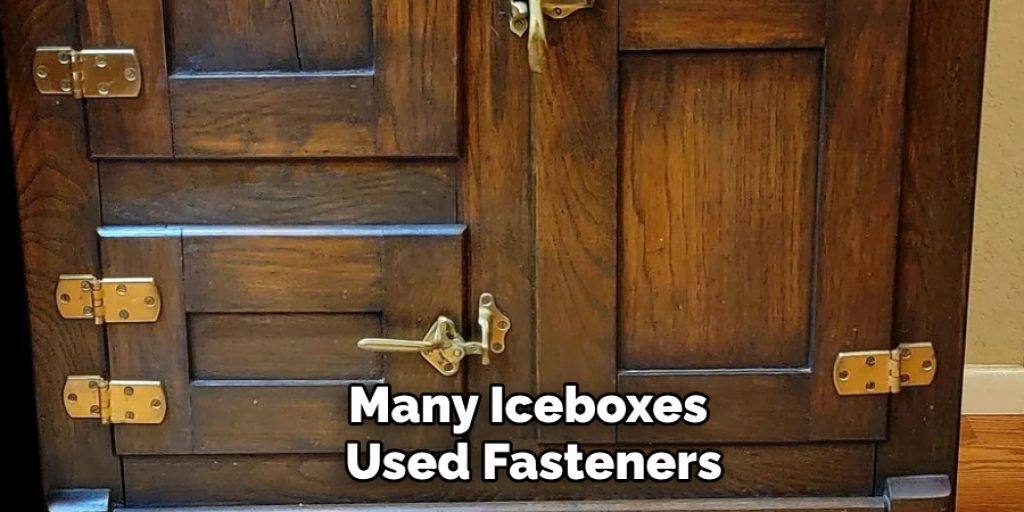
5. Hinges:
Antique iceboxes usually had leather or rubber gaskets for door hinges found on the front edge of the door. These were made in various shapes and could be stamped to describe the company’s name, address, patent number, or year. An early manufacturer will have several patents for each part of the icebox, which can be an efficient way to help date your icebox.
6. Metal Parts:
Some iceboxes have visible metal parts that can help to quickly narrow down an approximate manufacturing era or provide another dating clue. Look for patent marks on metal parts. They usually have a stylized format. Also, some manufacturers stamped their names on food grates and meat holders.
7. Wood:
Antique iceboxes typically were made of wood. The woods used were ash, alder, pine, poplar, mahogany, or oak. Knowing the types of woods used can help indicate a certain period for manufacturing. For example, mahogany was used in the early 1900s and people liked it because of its attractive appearance. Ash was used much later.
8. Large Switch:
Many iceboxes will have a large side-mounted switch that turns the electricity on and off. These were introduced in the 1920s, making it more convenient for users to turn on the icebox instead of reaching inside door shelves.
How Long Did Ice Boxes Last?
When iceboxes were first introduced, they weren’t as efficient as today’s refrigerators. As a result, people had to replace their ice boxes every year because the insulation wasn’t excellent, and the coolant would evaporate. Since then, ice boxes have become longer-lasting and more efficient.
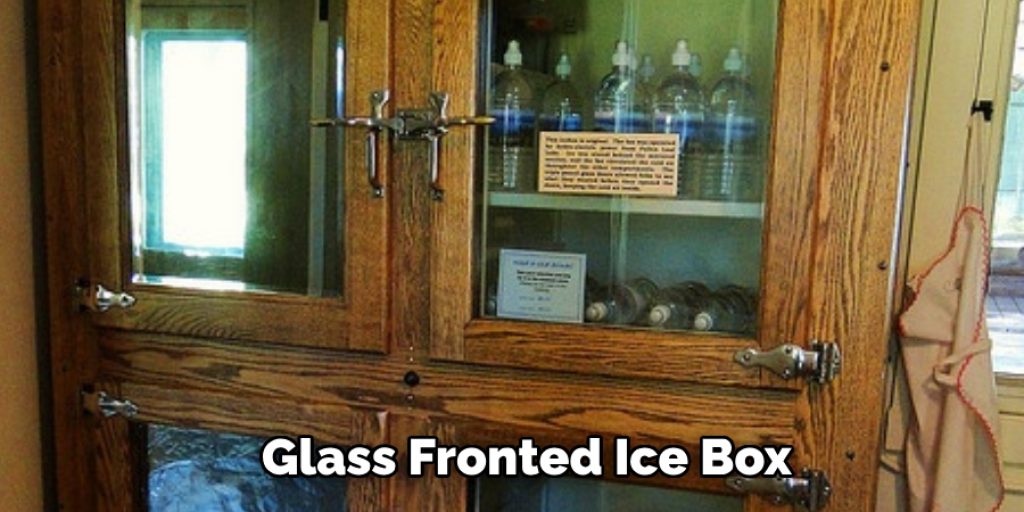
So, if your antique icebox is in good condition and all its parts are there, it’s probably still usable today. However, keep in mind that the insulation will wear out over time, and you’ll need to replace it when that happens, or the icebox won’t stay cold. If you are interested to know how to date an antique ice box consider reading this full blog post.
What Were Ice Boxes Made Out of?
Iceboxes were typically wood, lined with tin or zinc sheet metal. They often featured a marble floor inside to keep the ice from melting too quickly and an exterior made of wood boards and sheet metal designed to insulate and protect the ice inside. Some newer models had heavy wooden doors with rubber insulation gaskets around the edges and were more likely to be made of wood on all sides rather than metal.
Five Types of Ice Boxes:
1. Wood Box With Ice Compartment:
This is the most typical icebox you will find, and it may or may not come equipped with an external block and tackle for lifting the ice compartment. Typically, these boxes contain a window at the front door that allows you to view the ice chamber.
2. Ice Chest With Wooden Exterior:

This is the icebox equivalent of a “suitcase” picnic cooler. These boxes typically have a wooden exterior and may come equipped with an external block and tackle for lifting the ice chamber. The lids typically snap shut instead of having a latch on them, and they may or may not have a handle on them.
Like suitcases, these boxes are often covered with advertising. These boxes can be dated fairly easily because there were advertisements for them throughout the years, allowing you to narrow down the time frame when your box was made.
3. Metal Ice Chest With an Insulated Interior:
These are good examples of picnic coolers that would have been used in a park or at the beach. The interior of these box types is usually fully insulated, and it may come equipped with an external block and tackle for lifting the ice chamber.
Since they were intended for outdoor use, you will typically find that the exterior is painted red to prevent rust. Keep in mind that although this type of box features a wooden interior and exterior, it is still considered a type of ice chest. Although these boxes were intended for outdoor use, they can also be found in garages and basements.
4. Metal Cabinet With Metal Interior and Shelves:
This type of box is a combination of a refrigerator and a cabinet. The interior shelves will need to be manually positioned. Then, you have to physically remove the shelves to lower them into the ice compartment located at the top of this type of box. These boxes typically feature cabinets on either side intended for food storage, but they can also be found with one or two drawers.
5. Glass Fronted Ice Box:
This type of box is not necessarily an icebox, even though it may contain a compartment that would hold the ice. These boxes typically did not have to be raised using a block and tackle because they didn’t house any ice inside.
Instead, they dispensed or held a block of solid carbon dioxide (CO2) to keep the food in the box cool. The interior of these boxes was typically metal, and the exterior was usually wood with windows in them to allow you to view what was stored inside.
When Did Ice Boxes Stop Being Used?
Before the invention and popularization of electric refrigerators, iceboxes (or ice houses) were used to store food in warm weather. They contained large blocks or chunks of ice that would slowly melt, keeping food cold. The most common icebox type had a large interior compartment with dividers, adjustable shelves, and an ice chamber at the bottom. The storage area was located above the ice chamber.
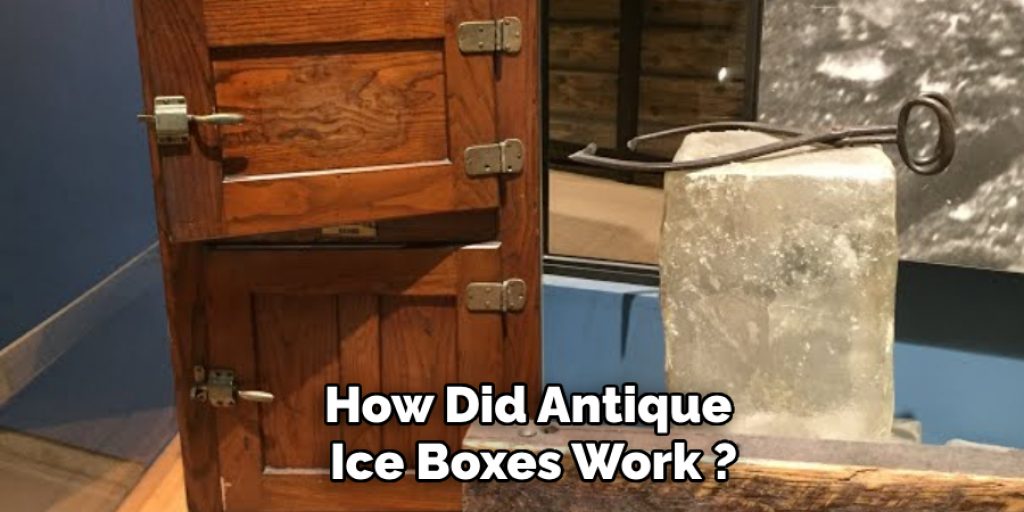
Most early models were similar in size to modern refrigerators, but they eventually evolved into smaller versions that fit inside a kitchen cabinet or pantry. They could either sit on a floor or counter or be hung from a wall. Early ice boxes did not have an electric motor and relied on good insulation to keep the cool temperature inside. Typically, there was a large ice chamber at the bottom and food storage above it. A drip pan would collect water that would melt and drain the unit.
Where to Find Antique Wooden Ice Box?
In the modern world, very few people need a wooden icebox. However, as a collector or as antique pieces, they can provide a unique glimpse into how things used to be. Today, these boxes are so rare that finding them can be difficult.
There may not be many left in existence, and those are often in terrible shape. As a result, it isn’t easy to know how old an icebox is. However, if you want to date one of these pieces, there are some things you can look for that will help narrow down the time frame.
How Did Antique Ice Boxes Work?
Before the advent of electric refrigerators, people kept their food cold with ice. And before there were commercial ice companies to deliver big blocks of crushed ice, people cut and stored their ice from local bodies of water during winter months or bought it directly from the lakeside iceman.
To preserve the sensitive foodstuffs brought in from the grocers and butchers, keep dairy products cold enough to avoid spoilage, and make ice cream; people held their foods using an “icebox” (originally known as a “refrigerator”). Iceboxes work by keeping a large block of ice frozen with minimal dripping.
Frequently Asked Questions:
Q: Can I Still Use an Antique Ice Box?
A: While it is possible to use an antique ice box for storage or display purposes, it is not recommended to use it as a functioning appliance. The insulation and materials used may not be safe for food storage and could potentially cause harm if consumed. It is best to use modern refrigeration methods for food storage. You can, however, still appreciate the antique ice box as a piece of history and craftsmanship.
Q: How Can I Tell the Age of an Antique Ice Box?
A: The age of an antique ice box can be determined by looking for certain features and characteristics. This includes the type of exterior material (wood, metal, etc.), the style of latches or handles, and any advertisements or markings present on the box. Researching these details can help narrow down the time frame in which the ice box was made. The presence of a drip pan can also be an indicator of age, as early models did not have this feature.
Q: Are Antique Ice Boxes Valuable?
A: As with any antique item, the value of an antique ice box depends on its condition, rarity, and demand. Some well-preserved or unique pieces can fetch a high price in auctions or from collectors. However, due to their age and limited use in modern times, antique ice boxes may not have as high a value compared to other antiques. It is best to consult with a professional appraiser to determine the value of a specific ice box.
Q: Can I Restore an Antique Ice Box?
A: It is possible to restore an antique ice box, but it should be done carefully and with caution. If you are planning to use the ice box for display purposes only, then a cosmetic restoration may be suitable. However, if you want to use it as a functioning appliance, it is important to consult with an expert in antique restoration to ensure the safety and preservation of the piece. Any major changes to the original design or materials could significantly decrease its value as an antique. So, it is crucial to carefully evaluate the decision to restore an antique ice box. Some may choose to keep it in its original state, appreciating the natural wear and patina that comes with age and use.

Q: Are There Still Ice Houses Today?
A: While the traditional method of using ice houses to store large blocks of ice may not be common anymore, modern versions are still in use today. For example, some restaurants and catering companies may use an “ice box” or refrigerated trailer to transport and store food at events. These are essentially portable versions of the traditional ice house and are still widely used in the food industry. Additionally, some people may choose to build their own modern version of an ice house for personal use. However, with modern refrigeration technology, the need for traditional ice houses has significantly decreased.
Conclusion:
You can now know the history of your antique icebox just by understanding how to date an antique ice box. All you need is a little bit of knowledge about what makes them different and where they come from, as well as some common sense detective work!
If you want more information on dating antiques or have any other questions for us, please don’t hesitate to contact our team today. We’ll be happy to help you figure out which category your item falls into soon enough!
You may also read How to Reheat Jack in the Box Tacos
You Can Check It Out To Identify a Fake Ww2 German Belt Buckle
You May Also Read How to Clean a Cedar Chest


